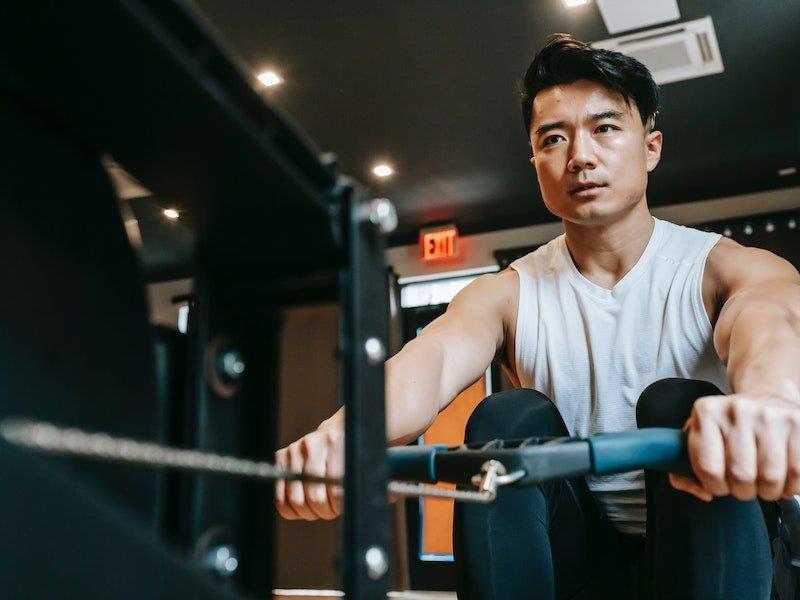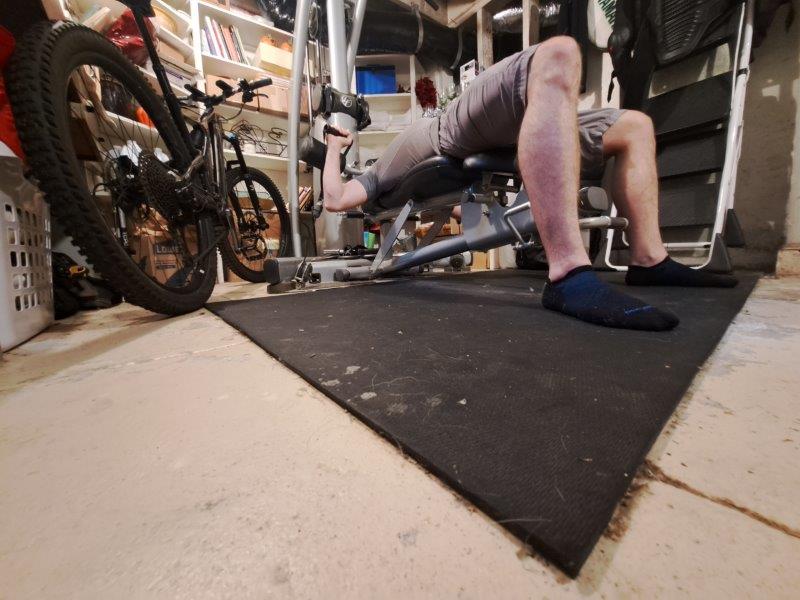We’ve all been there: you had an intense home workout, felt great immediately after, but then the next day (or even two days later), you’re greeted with that familiar soreness.
It’s as if your muscles are saying, “Hey, remember that workout? We sure do!”
In this article, we’ll share everything we know about muscle soreness after a workout, and more importantly, what you can do about it.

Understanding Muscle Soreness
First things first, let’s break down what’s happening when you feel sore.
When you work out, especially when trying a new activity or pushing your limits, tiny microscopic tears occur in your muscle fibers. This is completely normal and actually part of the process that allows muscles to grow and get stronger.
Acute Muscle Soreness kicks in just after your workout and lasts a short time, often because of a buildup of lactic acid. On the other hand, Delayed Onset Muscle Soreness, or DOMS, sets in a day or two later due to inflammation as your muscles repair and grow.
Believe it or not, some soreness can be a good thing! It can indicate that you’ve genuinely pushed your muscles and that they’re adapting and growing. However, it’s essential to know the difference between good soreness and potential injury.
Hint: It’s all about listening to your body.
Strategies to Reduce Muscle Soreness
While muscle soreness can be normal after a workout, that doesn’t mean it’s particularly enjoyable. Here are some of our top tips to reduce and prevent muscle soreness after you work out.
1. Hydration and Nutrition
Staying well-hydrated is an incredibly important part of muscle recovery. Water helps transport the essential nutrients required for muscle repair. If you don’t drink enough, your body is going to struggle to get your muscles what they need.
Along with hydration, we recommend fueling up with a good mix of protein and carbohydrates post-workout. Make sure you include foods rich in omega-3 fatty acids, like salmon or walnuts, as they can also be beneficial and help combat inflammation.
2. Slow Increases in Intensity
To give your muscles the best chance to adapt and minimize soreness, it’s important to gradually increase the intensity or volume of your workouts.
You don’t want to rush this step! The goal is to challenge the muscles without going overboard and straining them.
3. Change Up Your Training
Switching up your routine can do wonders. By incorporating different types of exercises, you can prevent the overuse of specific muscle groups. Consider balancing strength training with cardio and flexibility exercises for a comprehensive approach.
4. Foam Rolling and Myofascial Release
If you’ve never tried foam rolling, you’re in for a treat.
Rolling specific muscle groups on a cylindrical foam roller can help alleviate tightness. This pressure and rolling action aids in releasing muscle tension and can ease soreness. This is great to do both before and after workouts.
5. Wear Compression Clothing
Compression garments, whether they’re socks, sleeves, or leggings, can be helpful for some. This clothing can enhance circulation and potentially reduce muscle soreness. Some people swear by this clothing no matter what activity they’re doing.
6. Active Recovery
Rest is vital, but that doesn’t always mean staying completely still.
Engaging in low-intensity activities, such as walking or light swimming, can promote blood flow and aid in the removal of muscle breakdown by-products from sore areas. It’s also a nice way to rest without losing your momentum entirely.
7. Contrasting Showers
Have you tried alternating between cold and hot water during your showers? Though a cold shower doesn’t always sound nice, the cold helps reduce inflammation. Then, switching to the heat relaxes and eases tight muscles, promoting quicker recovery.
If you aren’t a fan of cold showers, an ice pack on your muscles before a hot shower can help too.
8. Over-the-Counter Pain Relievers
While not a long-term solution, non-prescription pain relievers like ibuprofen can offer temporary relief from muscle soreness. However, always consult with a healthcare professional before taking any medication you aren’t used to. However, we recommend trying alternative strategies before going this route.
9. Proper Stretching
A good stretch can make all the difference. Engaging in dynamic stretching before workouts prepares the muscles, while post-workout static stretching can increase flexibility and minimize tightness. It can also help prevent strains and injuries due to too-tight muscles.
10. Get Enough Sleep
Never underestimate the power of a good night’s rest! During deep sleep stages, your body actively works on repairing and regrowing tissues, including muscles. Not to mention all the good sleep does for your energy levels!
11. Electrolyte Balance
After an especially sweaty session, replenishing lost salts is essential. This can ward off cramps and reduce muscle soreness.
Post-workout beverages with added electrolytes, or natural sources like bananas, can be helpful.
12. Stay Consistent
While it may sound a bit ironic, regular workouts can lessen the onset and severity of DOMS over time. As you become more accustomed to the activity, your body adjusts, leading to decreased soreness. This is why starting a new workout can be so difficult, but you get used to it over time.

Signs You Might Need Extra Attention
Muscle soreness can be typical, but certain symptoms may indicate that it’s more than just the usual post-workout ache. If you experience any of these, we recommend seeing your doctor for an assessment.
Here are a few signs you might need some more care:
Persistent Pain: If the pain persists beyond the usual time frame for DOMS (around 24-72 hours post-exercise) and doesn’t show signs of subsiding, that’s a red flag.
Sharp, Shooting Pains: Generalized muscle soreness is one thing, but if you experience sharp, stabbing, or shooting pains, it might suggest something more severe, like a muscle strain or tear.
Swelling: While some inflammation can be expected after a tough workout, noticeable swelling in a muscle group or joint may indicate an injury.
Limited Range of Motion: If a particular joint or muscle group becomes significantly restricted in its movement post-workout, this could be a sign of injury or excessive inflammation.
Weakness or Instability: If a muscle group feels unusually weak, or if a joint feels unstable after a workout, it’s crucial to seek professional advice.
Bruising: Unexpected bruising can be a sign of a more severe muscle strain or another type of injury.
Numbness or Tingling: Any sensation of numbness or a “pins and needles” feeling that doesn’t go away can be a sign of nerve damage and should be addressed.

Busting Some Muscle Myths
Misconceptions around muscle soreness, development, and recovery can hinder progress and even lead to unintentional injury. By busting these myths, you can get on the road to healthier workout habits:
No Pain, No Gain
While pushing past comfort zones can be rewarding, pain should not be the measuring stick for an effective workout. Pain, especially sharp or persistent, is a signal from your body that something might be wrong. If the pain reaches levels beyond mild soreness, consider seeing a doctor.
Soreness Equals Muscle Growth
Just because you’re sore doesn’t mean your muscles are growing. Likewise, a lack of soreness doesn’t indicate ineffectiveness. Muscle soreness often results from trying a new activity or increasing intensity, not necessarily from muscle growth.
Lactic Acid Causes DOMS
It’s a widespread belief, but lactic acid is not the primary culprit for delayed soreness. DOMS is primarily caused by microscopic tears in muscle fibers during exercise. However, both of these together can cause soreness.
Stretching Prevents DOMS
While stretching can aid flexibility and potentially reduce injury risk, it doesn’t necessarily prevent DOMS entirely. It’s beneficial for range of motion and muscle function but isn’t a guaranteed shield against soreness.
More Protein Immediately After a Workout Speeds Up Recovery
While protein is essential for muscle repair and recovery, your body requires a balanced post-workout meal, including carbohydrates to replenish glycogen stores. Don’t rely entirely on that protein shake to fix all your problems.
Final Thoughts
While muscle soreness can be a badge of honor after a solid workout, it’s vital to approach it with knowledge and care. Listen to your body, prioritize recovery, and take the necessary steps to prevent soreness and injury.
While you’re here, check out some of our articles on nutrition, like the best protein bars for bodybuilders.
